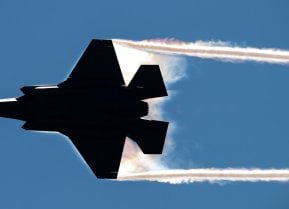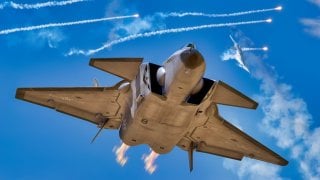China's J-20 Stealth Fighter: Created with Stolen Technology from F-22 and F-35?
Did China steal F-22 and F-35 designs to benefit its ongoing fighter efforts? The answer is unequivocally yes. But is that a reason to dismiss the threat posed by these aircraft and others to follow? No.
Despite the breadth of Su’s theft, many of the documents he and his hackers stole were not, strictly speaking, classified or even export-controlled. However, as the Air Force pointed out in 2016, even these less-significant thefts, in aggregate, allowed the Chinese military to reverse-engineer a wide variety of aircraft components that would otherwise have cost millions to develop from scratch, saving not only money, but a great deal of time associated with research and development.
“Su Bin admitted to playing an important role in a conspiracy, originating in China, to illegally access sensitive military data, including data relating to military aircraft that are indispensable in keeping our military personnel safe,” said Assistant Attorney General Carlin.
Su’s unearthed correspondence, the timeline of design changes incorporated into the Chengdu J-20 stealth fighter, and his subsequent admission of guilt, all point directly to China’s theft, and use, of Lockheed Martin design elements in its own fighter programs, though this idea remains the subject of debate within Pentagon and aviation circles to this day.
The J-20 is obviously not a direct copy of the F-22, and assertions that it would need to be to benefit from this sort of technological theft reflect a lack of understanding of fighter design. A tactical aircraft is, fundamentally speaking, not one thing, so much as a broad collection of components and design cues married to one another through functional form. Like a child bearing only a slight visual resemblance to her parents, genetic similarities run more than skin deep.
Yet, the most conspicuous similarities between Chinese and American stealth fighters are, nonetheless, fairly easy to spot. Despite the J-20’s overall delta-wing and canard design resembling Russia’s defunct MiG 1.44 stealth fighter effort, the radar-reflecting design cues leveraged by the F-22 and F-35 are readily visible in the Chinese fighter.
Some have disputed this in recent years by alleging that these similarities are based not on theft, but physics, claiming that these shared design elements are the inevitable result of any fighter design meant to marry aerobatic performance to low-observability. This claim would seem to be substantiated by numerous other stealth fighter programs in development today that also bear a striking resemblance to America’s F-22 or F-35, like Turkey’s KAAN, South Korea’s KF-21, or India’s AMCA.
The truth, however, is that both the Indian and South Korean stealth fighter efforts saw direct engineering support from Lockheed Martin, and Turkey’s KAAN fighter began development in 2016, three years before the country was removed from the F-35 program. These fighters bear a resemblance to Lockheed Martin’s because they all have benefitted from access to Lockheed Martin’s design efforts.
The idea that all stealth fighter designs will ultimately mature in the shape of an F-22 can be easily dismissed by simply looking over the competing stealth fighter developmental efforts from other firms that ultimately didn’t see production for one reason or another. Boeing’s admittedly goofy-looking X-32 and Northrop’s legendary YF-23, both jets that competed and lost against Lockheed entries, were not only broadly comparable in terms of stealth, but it’s widely understood that the YF-23 was even stealthier than the YF-22 that matured into today’s Raptor.
Other stealth aircraft efforts like Northrop’s Tacit Blue, Boeing’s YF-118G Bird of Prey, NASA’s X-36, McDonnell Douglas’s A-12 Avenger II, and more all represent different approaches to low-observable tactical aircraft design that bear little resemblance to Lockheed Martin’s approach.
Put simply, Lockheed Martin didn’t uncover the one-and-only approach to stealth fighter design in the early 1990s, leaving the rest of the world with no choice but to follow in its footsteps. Instead, Lockheed Martin offered the U.S. military the most viable combination of performance, stealth, and political support necessary to see its jets go into production. Since then, Lockheed Martin’s success with these designs has positioned it to support American allies and partners in their own developmental efforts, resulting in a great deal of similarity across some foreign designs.
China’s use of Lockheed Martin design elements in its stealth fighters, then, does not represent the inevitable result of radar and wind-tunnel testing, but rather a concerted effort to bridge the gap between Chinese and American fighter technology through a combination of direct theft and a fair bit of traditional domestic R&D.
So what does this ultimately mean for China’s J-20 or their new stealth fighter in development, the FC-31 (sometimes also known as the J-35)? Espionage has always played a role in the advancement of military technology and will continue doing so as long as wars are waged. These fighters do not need to match their American counterparts in all performance metrics to represent a potent threat to American security and interests, and indeed, they likely don’t. Their real value is as part of a broader defensive strategy and air warfare doctrine that China is still actively developing as we speak, and as such, the ultimate impact of these platforms has yet to fully manifest.
It would be a mistake to dismiss these copycat fighters as little more than designer-imposter jets with no real combat prowess due solely to their use of stolen design elements. A Hi-Point pistol may look like a Glock run through a broken copy machine and may not offer the same accuracy, reliability, or ease of maintenance… but that’s little solace to anyone who’s been shot by one. And the truth is, a highly trained special operator armed with nothing more than a cheap pistol may be even more dangerous to an opponent than a dummy like me with the fanciest Sig money can buy.
Effective employment strategies and tactics can often offset technological shortcomings, and as such, China’s employment of stealth technologies in new fighter designs doesn’t need to be as refined as America’s. With the right strategy, training, supporting systems, and personnel, the underdog can always come out on top.
So, did China steal F-22 and F-35 designs to benefit its ongoing fighter efforts? The answer is unequivocally yes.
But is that a reason to dismiss the threat posed by these aircraft and others to follow?
The answer there is unequivocally no.
About the Author: Alex Hollings
Alex Hollings is a writer, dad, and Marine veteran.
This first appeared in Sandboxx news.


